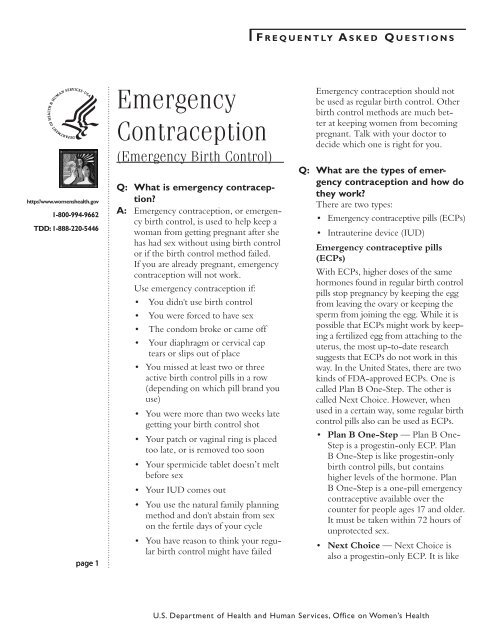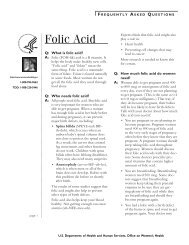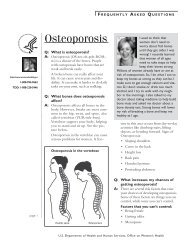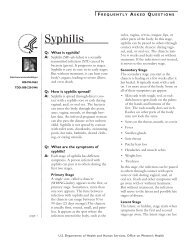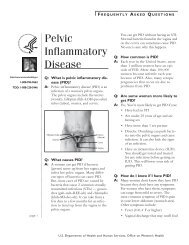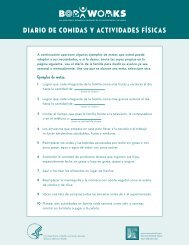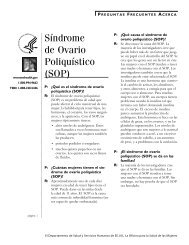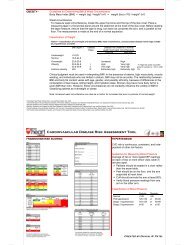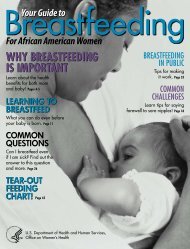Emergency Contraception Fact Sheet - WomensHealth.gov
Emergency Contraception Fact Sheet - WomensHealth.gov
Emergency Contraception Fact Sheet - WomensHealth.gov
You also want an ePaper? Increase the reach of your titles
YUMPU automatically turns print PDFs into web optimized ePapers that Google loves.
F r e q u e n t ly As k e d Qu e s t i o n shttp://www.womenshealth.<strong>gov</strong>1-800-994-9662TDD: 1-888-220-5446page 1<strong>Emergency</strong><strong>Contraception</strong>(<strong>Emergency</strong> Birth Control)Q: What is emergency contraception?A: <strong>Emergency</strong> contraception, or emergencybirth control, is used to help keep awoman from getting pregnant after shehas had sex without using birth controlor if the birth control method failed.If you are already pregnant, emergencycontraception will not work.Use emergency contraception if:• You didn't use birth control• You were forced to have sex• The condom broke or came off• Your diaphragm or cervical captears or slips out of place• You missed at least two or threeactive birth control pills in a row(depending on which pill brand youuse)• You were more than two weeks lategetting your birth control shot• Your patch or vaginal ring is placedtoo late, or is removed too soon• Your spermicide tablet doesn’t meltbefore sex• Your IUD comes out• You use the natural family planningmethod and don't abstain from sexon the fertile days of your cycle• You have reason to think your regularbirth control might have failed<strong>Emergency</strong> contraception should notbe used as regular birth control. Otherbirth control methods are much betterat keeping women from becomingpregnant. Talk with your doctor todecide which one is right for you.Q: What are the types of emergencycontraception and how dothey work?There are two types:• <strong>Emergency</strong> contraceptive pills (ECPs)• Intrauterine device (IUD)<strong>Emergency</strong> contraceptive pills(ECPs)With ECPs, higher doses of the samehormones found in regular birth controlpills stop pregnancy by keeping the eggfrom leaving the ovary or keeping thesperm from joining the egg. While it ispossible that ECPs might work by keepinga fertilized egg from attaching to theuterus, the most up-to-date researchsuggests that ECPs do not work in thisway. In the United States, there are twokinds of FDA-approved ECPs. One iscalled Plan B One-Step. The other iscalled Next Choice. However, whenused in a certain way, some regular birthcontrol pills also can be used as ECPs.• Plan B One-Step — Plan B One-Step is a progestin-only ECP. PlanB One-Step is like progestin-onlybirth control pills, but containshigher levels of the hormone. PlanB One-Step is a one-pill emergencycontraceptive available over thecounter for people ages 17 and older.It must be taken within 72 hours ofunprotected sex.• Next Choice — Next Choice isalso a progestin-only ECP. It is likeU.S. Department of Health and Human Services, Office on Women’s Health
F r e q u e n t ly As k e d Qu e s t i o n shttp://www.womenshealth.<strong>gov</strong>1-800-994-9662TDD: 1-888-220-5446page 2progestin-only birth control pills,but has higher levels of the hormone.Next Choice is two pills. Thefirst pill should be taken as soon aspossible within 72 hours of unprotectedsex. The second pill shouldbe taken 12 hours after the first pill.Next Choice is available over thecounter for people ages 17 and older.• Higher dose of regular birthcontrol pills — The number ofpills in a dose is different for eachpill brand, and not all brands can beused for emergency contraception.For more information on birthcontrol pills that can be used foremergency contraception, visit the<strong>Emergency</strong> <strong>Contraception</strong> Website(not-2-late.com). The pills aretaken in 2 doses (1 dose right away,and the next dose 12 hours later).Always use the same brand for bothdoses, and be sure to use the activepills, not the reminder pills.You should always take ECPs as soonas you can after having unprotected sex,but they can work up to 5 days later insome cases. However, if you use PlanB One-Step or Next Choice as emergencycontraception, you should takeyour first pill within 72 hours of unprotectedsex. Women who are breastfeedingor cannot take estrogen should useprogestin-only ECPs (like Plan B One-Step). Some women feel sick and throwup after taking ECPs. If you throw upafter taking ECPs, call your doctor orpharmacist.Intrauterine device (IUD)The IUD is a small, T-shaped deviceplaced into the uterus by a doctor within5 days after having unprotected sex.The IUD works by keeping the spermfrom joining the egg or keeping a fertilizedegg from attaching to the uterus.Your doctor can remove the IUD afteryour next period. Or, it can be left inplace for up to 10 years to use as yourregular birth control method.Q: How well does emergency contraceptionwork?A: When used correctly, emergency contraceptivepills (ECPs) work very wellat preventing pregnancy. Consider thatabout 8 in 100 women who have unprotectedsex one time during the fertilepart of their cycle will become pregnant.If these 100 women take progestin-onlyECPs (like Plan B One-Step or NextChoice), about 1 will become pregnant.If 100 women take ECPs with estrogenand progestin, about 2 will becomepregnant. The IUD works even better.Only 1 in 1,000 women who have anIUD put in after having unprotected sexwill become pregnant.The sooner you use emergency contraceptionafter unprotected sex, the morelikely it will prevent pregnancy. But youmust use it correctly. For regular birthcontrol pills used as ECPs, take the firstdose within 3 days of having unprotectedsex, but no later than 5 days. Takethe second dose 12 hours later. For PlanB One-Step, only one pill is needed butit should be taken within 72 hours ofsex. For Next Step, the first pill shouldbe taken within 72 hours of sex and thesecond pill 12 hours later.Q: Does emergency contraceptionhave side effects?Some women feel sick and throw upafter taking ECPs. Headache, dizziness,lower stomach cramps, irregularbleeding, breast tenderness, and fatiguealso can occur. Progestin-only ECPscause fewer side effects than combinedpills that also contain estrogen. TheU.S. Department of Health and Human Services, Office on Women’s Health
F r e q u e n t ly As k e d Qu e s t i o n shttp://www.womenshealth.<strong>gov</strong>1-800-994-9662TDD: 1-888-220-5446page 3over-the-counter drug Dramamine 2can reduce the risk of feeling sick andthrowing up. Take two of these pills30 minutes before taking ECPs. If youthrow up after taking ECPs, call yourdoctor or pharmacist.IUD placement has risks of pelvicinfection or harming the uterus. Butthese risks are quite rare. If the IUD isleft in place to be used as birth control,it can cause side effects such as crampsand heavy bleeding during your period.Q: Will emergency contraceptionprotect me from sexually transmittedinfections (STIs)?A: No. <strong>Emergency</strong> contraception can onlylower the risk of becoming pregnantafter having unprotected sex. Alwaysuse condoms to lower your risk of gettingan STI.Q: Are emergency contraceptivepills (ECPs) the same thing asthe "morning after pill"?A: Yes. ECPs are often called the "morningafter pill," which is wrong because ECPsdon’t have to be taken the morningafter. You should always take ECPs assoon as you can after having unprotectedsex, but some kinds can work up to 5days later.Q: How do I get emergency contraceptivepills (ECPs)?A: You can get Plan B One-Step or NextChoice at drugstores and stores with alicensed pharmacist. The FDA approvedPlan B One-Step and Next Choice forsale without a prescription to those 17and older. Women and men must showproof of age to buy Plan B One-Stepor Next Choice. If you are youngerthan 17 and need emergency contraception,you will need a prescription,so act quickly. Talk to your parents,your doctor, or visit a family planningclinic and ask for help. In some states(Alaska, California, Hawaii, Maine,Massachusetts, New Hampshire, NewMexico, Vermont, and Washington),some pharmacists can provide Plan BOne-Step or Next Choice to womenyounger than 17 without a prescription.If you live in one of these states, callyour pharmacy to see if this is an optionfor you.Q: I heard that 17-year-olds cannow buy ECPs without a prescription— is that true?A: Yes. Plan B One-Step and NextChoice are currently available for saleover the counter to people 17 andolder. It remains prescription-only forthose under 17. Take proof of your agewith you, and call ahead to make sureyour pharmacy stocks emergency contraception.Q: Can I get emergency contraceptivepills (ECPs) before I needthem?A: Yes. Your doctor should bring up ECPsat your annual exam (when you have aPap test). If your doctor does not talkabout emergency contraception at yournext exam, ask your doctor about it.Q: What do I need to do after Itake emergency contraceptivepills (ECPs)?A: After you have taken ECPs, your nextperiod may come sooner or later thannormal. Most women will get theirperiod within 7 days of the expecteddate. Your period also may be heavier,U.S. Department of Health and Human Services, Office on Women’s Health
F r e q u e n t ly As k e d Qu e s t i o n sFor more informationFor more information on emergency contraception, contact womenshealth.<strong>gov</strong> at 1-800-994-9662 or the following organizations:http://www.womenshealth.<strong>gov</strong>1-800-994-9662TDD: 1-888-220-5446Food and Drug AdministrationPhone Number: (888) 463-6332Internet Address: http://www.fda.<strong>gov</strong><strong>Emergency</strong> <strong>Contraception</strong> Website(not-2-late.com)Internet Address: http://ec.princeton.eduPlanned Parenthood Federation ofAmericaPhone Number: (800) 230-7526Internet Address: http://www.plannedparenthood.orgAll material contained in this FAQ is free of copyright restrictions, and may be copied,reproduced, or duplicated without permission of the Office on Women's Health in theDepartment of Health and Human Services. Citation of the source is appreciated.This FAQ was reviewed by:James Trussell, PhDProfessor of Economics and Public AffairsDirector, Office of Population ResearchPrinceton UniversityContent last reviewed May 15, 2009.Content last updated November 21, 2011.page 4U.S. Department of Health and Human Services, Office on Women’s Health


